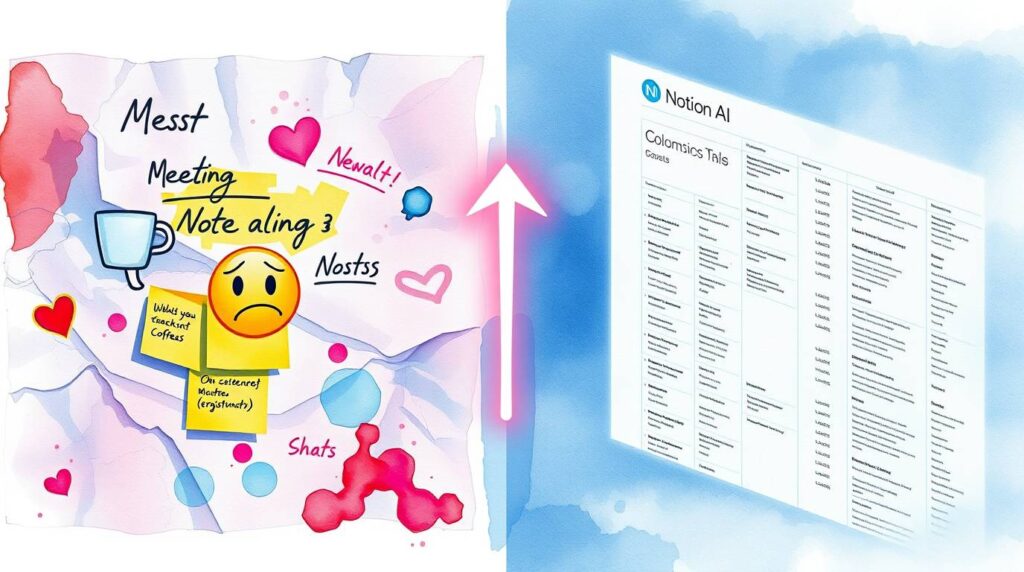You just survived another marathon team meeting. Your notes are a cryptic blend of action items, decisions, random ideas, and half-remembered deadlines. Sound familiar? That post-meeting scramble to do something with those notes is a universal productivity killer. What if you could instantly transform that fragmented text into a structured, searchable, actionable database? Enter Notion AI – not just a note-taking upgrade, but a revolutionary workflow engine. Let’s explore how it automates the tedious, turning your meeting chaos into organized clarity.
The Meeting Notes Nightmare: Why We Need Rescue
Most meetings generate valuable insights that die in unstructured documents. Key issues fester:
- Lost Actions: Critical tasks buried in paragraphs vanish.
- Decision Amnesia: “What did we agree on?” becomes a recurring question.
- Data Silos: Notes live isolated in docs, disconnected from project trackers or CRMs.
- Wasted Hours: Manual sorting, tagging, and data entry drain resources.
Traditional methods fail. Manually building databases post-meeting is slow and error-prone. Generic AI summarizers (like those in Otter.ai or Zoom) create condensed narratives, not structured, quarriable data. This is where Notion AI fundamentally shifts the paradigm.
Notion AI: Beyond Summarization, Into Structure
Notion AI is more than a chatbot within your workspace. It’s a contextual intelligence layer that understands your content and your workspace structure. Unlike tools merely summarizing text, Notion AI can interpret meeting notes and generate ready-to-use databases – the backbone of organization in Notion. Think tables with automatically populated properties like:
- Tasks (with assignees & due dates)
- Decisions (with owners and context)
- Ideas (tagged by project or theme)
- Key Metrics/Data Points (extracted into relevant fields)
Your Meeting Notes → Notion Database: The Step-by-Step Magic
Here’s how to leverage Notion AI to transform raw notes into dynamic databases:
- Capture Raw Notes (Effortlessly):
- Dump everything into a Notion page during or right after the meeting. No formatting needed. Include verbal cues like “ACTION,” “DECIDED,” “IDEA.”
- Summon Notion AI & Command the Transformation:
- Highlight your messy notes.
- Activate Notion AI (Spacebar or /ai command).
- Use a prompt like:
“Transform these meeting notes into a database with the following properties: ‘Task’ (text), ‘Assignee’ (person), ‘Due Date’ (date), ‘Status’ (select: To Do, In Progress, Done), ‘Category’ (select: Development, Marketing, Operations), ‘Notes’ (text). Extract action items, decisions, and key points accordingly.”
- Review & Refine (Human-in-the-Loop):
- Notion AI generates a draft database. Crucially, it doesn’t just paste text. It parses your notes, identifies relevant info, and populates the correct columns.
- Example: It detects “John to finalize blog draft by Friday” and creates a row with Task=”Finalize blog draft”, Assignee=”John”, Due Date=”[Upcoming Friday]”, Status=”To Do”, Category=”Marketing”.
- Scan the output. Use Notion AI again for quick tweaks: “Make all ‘Due Date’ fields bold” or “Change the ‘Category’ for task X to ‘Content'”.
- Integrate & Activate:
- Instantly connect this new database to your existing workspace:
- Link tasks to a master project tracker.
- Sync decisions to a team decisions log.
- Pipe ideas into an innovation backlog.
- Set up filtered views (e.g., “My Actions,” “Urgent Deadlines”).
- Instantly connect this new database to your existing workspace:
The Result: Your meeting’s value is no longer trapped in a document. It’s live, organized data driving action.
Why This Isn’t Just Cool – It’s Transformational
- Slash Post-Meeting Admin: Cut hours of manual data entry down to minutes of review. A Forrester study on AI automation highlights potential for 40%+ time savings on repetitive tasks like this.
- Capture Everything, Lose Nothing: Fragile action items and subtle decisions are systematically captured, not lost in the shuffle.
- Create a Living Knowledge Base: Databases generated over time become a searchable archive of team decisions, action history, and evolving ideas. Find anything instantly.
- Boost Accountability: Clear assignees, visible due dates, and status updates make ownership undeniable.
- Unlock Insights: Filter and sort databases to see patterns – e.g., recurring bottlenecks, frequent contributors, project timelines.
Real-World Impact: Beyond Theory
Imagine:
- Sales Teams: Transform discovery call notes into a structured pipeline database (Company, Pain Points, Next Steps, Follow-Up Date) instantly.
- Product Teams: Turn user feedback sessions into a prioritized feature request backlog.
- Leadership: Convert strategy meeting rambles into a clear OKR (Objectives and Key Results) tracking database.
- Personal Use: Process 1:1 meeting notes into personal task lists and growth trackers.
Personal Experience: After a chaotic product brainstorm, I fed 3 pages of notes into Notion AI with a prompt for a feature database (Name, Description, Priority, Effort Estimate, Owner). In 90 seconds, I had a structured table. Manually, it would have taken 30+ minutes and constant context-switching. The real win? Two weeks later, I queried “High Priority, Low Effort” features and instantly had a sprint candidate list.
Notion AI vs. The Alternatives: Why It Wins for Database Creation
| Feature | Manual Entry | Generic AI Summarizers | Notion AI Database Gen |
| Time Required | High (30-60+ mins) | Medium (Summaries) | Low (2-5 mins) |
| Output Structure | Database | Narrative Text | Interactive Database |
| Actionability | High (Eventually) | Low | High (Immediate) |
| Integration | Manual | None/Copy-Paste | Native (Notion) |
| Query/Search Ability | Yes | Limited | Yes (Robust) |
| Context Awareness | Human | Low | High (Your Workspace) |
Avoiding Pitfalls & Pro Tips
- Garbage In, Garbage Out: While Notion AI is powerful, clear notes yield the best results. Capture key phrases explicitly (“DECIDE: We will use Platform X”).
- Specificity Wins: Tailor your prompts. Instead of “make a database,” define exact properties needed.
- Review is Non-Negotiable: AI isn’t perfect. Check for accurate extraction, especially dates, names, and nuanced context.
- Iterate Your Prompts: Save successful prompts as templates for recurring meeting types (e.g., “Sprint Planning DB Generator”).
- Combine with Notion Superpowers: Link generated databases to calendars (for due dates), project pages, or dashboards.
Beyond Meetings: The Ripple Effect of Automated Databases
This capability hints at Notion AI’s broader potential: structuring unstructured information anywhere. Imagine:
- Turning email threads into task lists.
- Converting research snippets into annotated bibliographies.
Transforming interview transcripts into candidate evaluation matrices.
The core idea – AI parsing text to populate structured data fields – is a productivity superpower waiting to be applied universally.
Getting Started: Your First AI-Generated Database
- Enable Notion AI: Ensure you have an active subscription.
- Pick a Recent Meeting: Start with notes you already have.
- Define Your Goal: What database structure would make this info most useful? (Tasks? Decisions? Resources?).
- Craft Your Prompt: Be specific about properties (use Notion property types: text, date, person, select, etc.).
- Generate & Refine: Run it, review, tweak with follow-up AI commands.
- Connect & Conquer: Link the new DB to relevant pages/views.
Ready to ditch the post-meeting scramble?
Your fragmented notes are a goldmine waiting to be structured. Notion AI is the refinery. Give it a try on your very next meeting doc. Highlight, prompt, and witness the chaos transform into clarity. Share your most successful (or hilarious) database generation prompts in the comments below – let’s build the ultimate toolkit together! What meeting note mess will you conquer first?
Notion’s AI documentation for database automation
👉Other AI Tools –> Please click here




